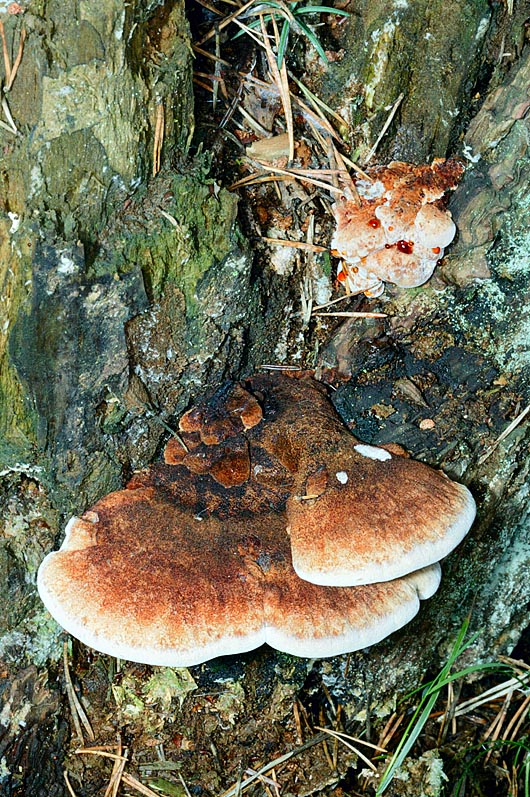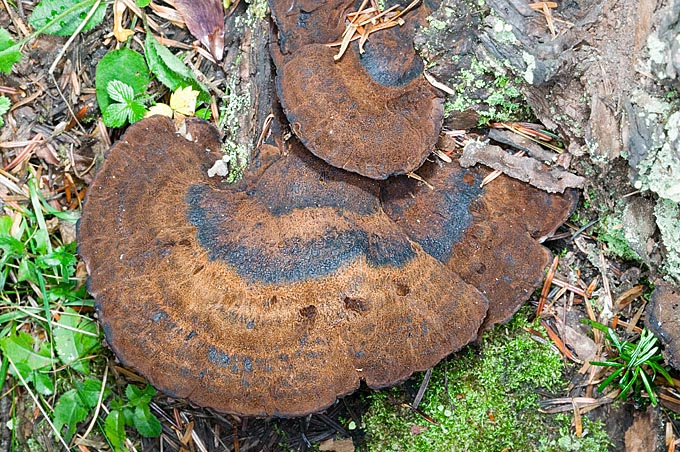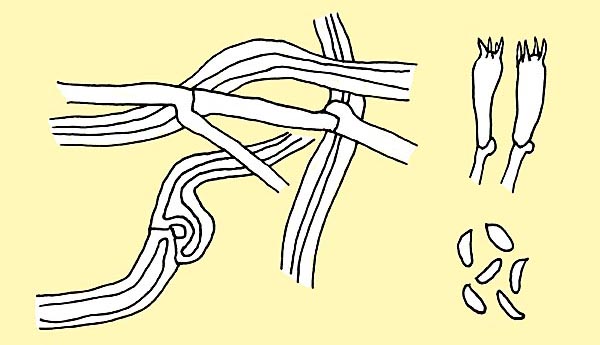
Text © Massimiliano Berretta

English translation by Mario Beltramini

Ischnoderma benzoinum growing specimens with watery droplets © Giuseppe Mazza
Family: Fomitopsidaceae Jülich, 1982.
Genus: Ischnoderma P. Karsten, 1879.
Ischnoderma benzoinum (Wahlenberg) P. Karsten, 1879.
The epithet “benzoinum” comes from the Latin “benzoinus” = with odour of balsamic resin obtained from the Styrax benzoin of India.
In Italy and in Spain there are no “common” names for this species; in France, on the contrary, it is known as “Polypore balsamique”; in Germany “Schwarz- gebänderter Harzporling”; in the UK “Benzoin Bracket”.
Description of the genus
To this genus belong annual, sessile bracketed basidiomes, often fan-shaped; initially soft then very hard, with a tomentose pileus surface which then becomes crusty, of colour from dark brown to blackish. Whitish porous hymenium which darkens when touched. Dimitic hyphal system having generative hyphae with clamp connections and hyaline or brown skeletal hyphae, cylindrical basidiospores, not amyloid, smooth, white in mass. Saprotrophic species to conifers and broad-leaved trees, agents of white rot. The type species is Ischnoderma resinosum (Fries) P. Karsten 1879.
Description of the species
Cap: sessile, flat basidiomes, up to 20 cm long, with up to 14 cm radius and 2 cm thick, the young specimens have finely tomentose surface and fleshy consistency, red-brown or brown, then become hard and with black resinous crust with concentric zonations, the border is always paler and wavier and often bent downwards.
Hymenium: whitish, round-angular pores, 4-6 per mm, in older specimens they become brown, darken if touched, brown tubules of about 1 cm of length.
Stipe: absent.
Flesh: the context is about 1 cm thick, tender and whitish when young, ochreous and hard when ripening.
Habitat: it develops mainly in autumn almost exclusively on conifers.
Edibility: of no value.

Even 20 cm long, with up to 14 cm radius, initially tomentose and fleshy, then crusty and hard © Giuseppe Mazza
Reactions: the context becomes brown-black with the KOH.
Microscopy
Dimitic hyphal structure with pale yellow skeletal hyphae thick-walled, of 3-6 µm of diameter, generative septate hyphae, hyaline, with clamp connections, of 3-8 µm of diameter. Absence of cystidia and of cystidioles. Clavate basidia, tetrasporic, hyaline, with basal clamp connection, of 10-15 × 3,5-4,5 µm. Cylindrical basidiospores, hyaline, smooth, inamyloid, with thin walls, folded on a side, measuring 5-6 × 2-2,5 µm.
Remarks
It is a fairly diffused species in the boreal hemisphere, not frequent in Italy, the other species of the genus, Ischnoderma resinosum (Fries) P. Karsten 1879, is macroscopically very similar, but it grows exclusively on broad-leaved trees, preferably beech (Fagus sylvatica).
A possible confusion might occur with Meripilus gigantesus (Persoon) P.Karsten 1882, which, however, is easily recognizable due to its darkening when touched, not instantaneous, in all its parts, and for the preferred growth on Castanea sativa and Fagus sylvatica furthermore, the spores are ellipsoidal and bigger, 5,5-7,5 × 4,5-6 µm.

Ischnoderma benzoinum generative and skeletal hyphae, basidia and spores © Pierluigi Angeli
It can be also mistaken with Bondarzewia mesenterica (Schaeffer) Kreisel 1984, which, even if sharing the same habitat, grows on surfacing roots of Picea abies and Abies alba, has however whitish, angular and irregular pores, the tubules and the context are concolorous, the hyphae do not have clamp connections, the spores are amyloid, subglobose and warty.
Synonyms: Boletus benzoinus Wahlenberg, 1826 (basionym); Ischnoderma resinosum f. benzoinum (Wahlenberg) Pilát, 1937; Lasiochlaena benzoina (Wahlenberg) Pouzar, 1990; Polyporus benzoinus (Wahlenberg) Fries, 1828; Polystictus benzoinus (Wahlenberg) Bigeard & H. Guillemin, 1913; Trametes benzoina (Wahlenberg) Fries, 1838; Ungulina benzoina (Wahlenberg) Patouillard, 1900.
→ For general notions about Fungi please click here.
→ To appreciate the biodiversity of MUSHROOMS please click here.
